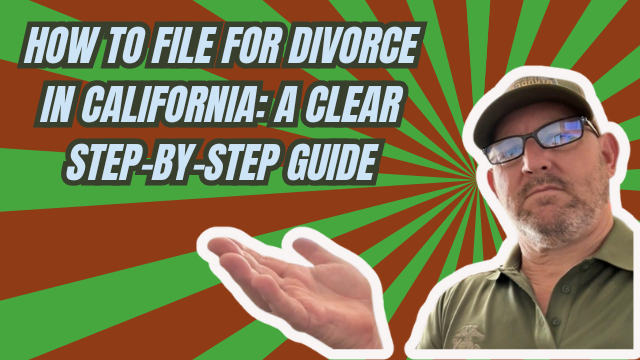How to File for Divorce in California: A Clear Step-by-Step Guide
Hi — I’m Tim Blankenship with Divorce661. In this guide I’ll walk you through the exact steps to file for divorce in California, explain the critical pitfalls to avoid, and show how modern tools like e-filing can make the process faster and less stressful. I’ve helped couples finish their divorce quickly and affordably — sometimes without ever stepping foot in court — and this is the roadmap I use.
Overview: The very first step matters
The moment you decide to file, you start a court case. That means certain documents must be prepared and filed correctly to open your case and keep things moving. The most important initial papers are:
- Petition (the formal request to the court to end the marriage)
- Summons (tells the other spouse a case has been filed)
- The child jurisdiction form (for custody/children cases — commonly the UCCJEA)
Submit these documents to the court to officially open your file. Getting this right prevents delays from the very beginning.
Serving your spouse: do it correctly
After filing, your spouse must be served with the papers. Service can be done in a few ways depending on how cooperative the other party is:
- Personal service — a third party hands the documents directly to your spouse.
- Service by mail — when your spouse is cooperative, you can use a Notice & Acknowledgement of Receipt (signed by them) to accept service by mail.
Common pitfall: improper or incomplete service can stop your case in its tracks. If service isn’t done correctly, the court may not proceed and you’ll face unnecessary delays.
Financial disclosures — transparency is non‑negotiable
Financial transparency is non-negotiable.
California requires both parties to exchange financial information. Even if you and your spouse already agree on property division or support, these disclosures are mandatory. Typical elements include:
- A schedule of assets and debts
- Income and expense details
- Supporting documents (bank statements, paystubs, tax returns, etc.)
Why this matters: complete and accurate disclosures protect both parties and enable fair settlement. Missing or inaccurate information can lead to disputes, delays, or a court reopening your settlement later on.
When you agree: draft a Marital Settlement Agreement
If both parties are on the same page about property, custody, and support, the next step is to put those agreements into writing as a Marital Settlement Agreement (MSA). The MSA is the document the court will incorporate into the judgment, so be clear and thorough.
An effective MSA covers:
- Division of assets and debts
- Child custody and visitation plans
- Child and spousal support terms
- Any other agreements (healthcare, taxes, etc.)
Use e-filing where available — save time and avoid court appearances
Many California counties support e-filing, which makes the process much more convenient. Counties where Divorce661 currently e-files include Los Angeles, Orange, Riverside, and San Bernardino. Benefits of e-filing:
- No in-person filing at the courthouse
- Faster document processing
- Less time off work and reduced stress
Real-life example: we helped a couple finalize their divorce in just a few weeks without ever appearing in court thanks to e-filing and properly prepared paperwork. When the paperwork is complete and both parties cooperate, you can often avoid court entirely.
Step-by-step checklist to file for divorce in California
- Prepare the Petition and Summons, plus the child jurisdiction form (if there are children).
- File the papers with the court to open your case.
- Serve your spouse correctly (personal service or Notice & Acknowledgement of Receipt for cooperative spouses).
- Exchange financial disclosures (schedule of assets and debts and other supporting documents).
- If you agree, draft and sign a Marital Settlement Agreement covering property, custody, and support.
- File settlement documents and request judgment — use e-filing when available to avoid court appearances.
Common mistakes to avoid
- Failing to serve the spouse properly — service errors cause delays.
- Skipping mandatory financial disclosures — even in amicable cases.
- Leaving the Marital Settlement Agreement vague — ambiguity invites future disputes.
- Assuming every county allows e-filing — check local rules.
Next steps and where to get help
If you’re ready to move forward but don’t want to navigate the paperwork alone, we offer flat-fee, full-service divorces across California. We handle filing, service, disclosures, drafting the Marital Settlement Agreement, and the judgment filings. Visit divorce661.com to schedule a free consultation and learn how we can help you finish your divorce efficiently and affordably.
Questions? Which step seems most confusing to you? Reach out — we’ll answer and guide you through the process.

